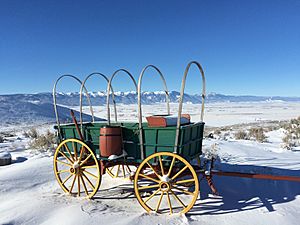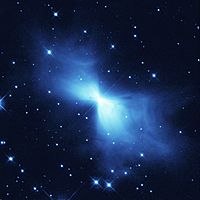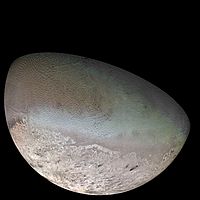Cold facts for kids
Cold is the presence of low temperature, especially in the atmosphere. In common usage, cold is often a subjective perception. A lower bound to temperature is absolute zero, defined as 0.00 K on the Kelvin scale, an absolute thermodynamic temperature scale. This corresponds to −273.15 °C on the Celsius scale, −459.67 °F on the Fahrenheit scale, and 0.00 °R on the Rankine scale.
Since temperature relates to the thermal energy held by an object or a sample of matter, which is the kinetic energy of the random motion of the particle constituents of matter, an object will have less thermal energy when it is colder and more when it is hotter.
Contents
Cooling
Cooling refers to the process of becoming cold, or lowering in temperature. This could be accomplished by removing heat from a system, or exposing the system to an environment with a lower temperature.
Coolants are fluids used to cool objects, prevent freezing and prevent erosion in machines.
Air cooling is the process of cooling an object by exposing it to air. This will only work if the air is at a lower temperature than the object, and the process can be enhanced by increasing the surface area or decreasing the mass of the object.
Another common method of cooling is exposing an object to ice, dry ice, or liquid nitrogen. This works by convection; the heat is transferred from the relatively warm object to the relatively cold coolant.
Laser cooling and magnetic evaporative cooling are techniques used to reach very low temperatures.
19th century
In the United States from about 1850 till end of 19th century export of ice was second only to cotton. The first ice box was developed by Thomas Moore, a farmer from Maryland in 1810 to carry butter in an oval shaped wooden tub. The tub was provided with a metal lining in its interior and surrounded by a packing of ice. A rabbit skin was used as insulation. Moore also developed an ice box for domestic use with the container built over a space of 6 cuft which was filled with ice. In 1825, ice harvesting by use of a horse drawn ice cutting device was invented by Nathaniel J. Wyeth. The cut blocks of uniform size ice was a cheap method of food preservation widely practiced in the United States. Also developed in 1855 was a steam powered device to haul 600 tons of ice per hour. More innovations ensued. Devices using compressed air as a refrigerants were invented.
20th century
Iceboxes were in widespread use from the mid-19th century to the 1930s, when the refrigerator was introduced into the home. Most municipally consumed ice was harvested in winter from snow-packed areas or frozen lakes, stored in ice houses, and delivered domestically as iceboxes became more common.
In 1913, refrigerators for home use were invented. In 1923 Frigidaire introduced the first self-contained unit. The introduction of Freon in the 1920s expanded the refrigerator market during the 1930s. Home freezers as separate compartments (larger than necessary just for ice cubes) were introduced in 1940. Frozen foods, previously a luxury item, became commonplace.
Physiological effects
Cold has numerous physiological and pathological effects on the human body, as well as on other organisms. Cold environments may promote certain psychological traits, as well as having direct effects on the ability to move. Shivering is one of the first physiological responses to cold. Extreme cold temperatures may lead to frostbite, sepsis, and hypothermia, which in turn may result in death.
Cold locations and objects
- The Boomerang Nebula is the coldest known place in the universe. Scientists believe the temperature is 1 K (kelvin) (−272.15 °C/−457.87 °F).
- Herschel Space Observatory equipment is kept at temperatures below 2 K, using a large helium tank for cooling.
- Neptune's moon Triton has a surface temperature of −235 °C (−390 °F).
- Uranus has an atmospheric temperature of −215 °C (−355 °F).
- Saturn has a temperature of −175 °C (−285 °F) at cloud tops.
- Mercury, even though it is close to the Sun, is actually cold during the night. It has a temperature of about −170 °C (−275 °F). Mercury is cold at night because it has no atmosphere to trap in heat from the Sun.
- Jupiter has a temperature of −145 °C (−230 °F) at the cloud tops.
- Mars has a temperature of about −125 °C (−195 °F).
- The coldest continent on Earth is Antarctica. The coldest place on Earth is the Antarctic Plateau, an area of Antarctica around the South Pole that has an altitude of around 3000 meters. The lowest measured temperature on Earth, −89.2 °C (−128.6 °F), was recorded at Vostok Station on 21 July 1983.
Images for kids
-
An iceberg, which is commonly associated with cold
-
Goose bumps, a common physiological response to cold, aiming to reduce the loss of body heat in a cold environment
-
A photograph of the snow surface at Dome C Station, Antarctica a part of the notoriously cold Polar Plateau, it is representative of the majority of the continent's surface
-
Cold desert of the Himalayas in Ladakh
See also
 In Spanish: Frío para niños
In Spanish: Frío para niños















